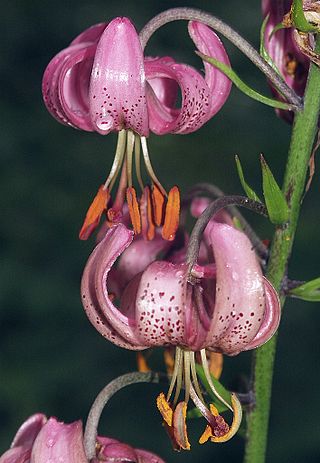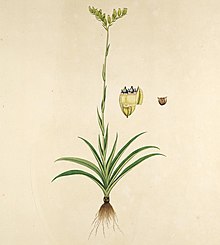
Asparagales is an order of plants in modern classification systems such as the Angiosperm Phylogeny Group (APG) and the Angiosperm Phylogeny Web. The order takes its name from the type family Asparagaceae and is placed in the monocots amongst the lilioid monocots. The order has only recently been recognized in classification systems. It was first put forward by Huber in 1977 and later taken up in the Dahlgren system of 1985 and then the APG in 1998, 2003 and 2009. Before this, many of its families were assigned to the old order Liliales, a very large order containing almost all monocots with colorful tepals and lacking starch in their endosperm. DNA sequence analysis indicated that many of the taxa previously included in Liliales should actually be redistributed over three orders, Liliales, Asparagales, and Dioscoreales. The boundaries of the Asparagales and of its families have undergone a series of changes in recent years; future research may lead to further changes and ultimately greater stability. In the APG circumscription, Asparagales is the largest order of monocots with 14 families, 1,122 genera, and about 36,000 species.

The Dioscoreales are an order of monocotyledonous flowering plants, organized under modern classification systems, such as the Angiosperm Phylogeny Group or the Angiosperm Phylogeny Web. Among monocot plants, Dioscoreales are grouped with the lilioid monocots, wherein they are a sister group to the Pandanales. In total, the order Dioscoreales comprises three families, 22 genera and about 850 species.

Liliales is an order of monocotyledonous flowering plants in the Angiosperm Phylogeny Group and Angiosperm Phylogeny Web system, within the lilioid monocots. This order of necessity includes the family Liliaceae. The APG III system (2009) places this order in the monocot clade. In APG III, the family Luzuriagaceae is combined with the family Alstroemeriaceae and the family Petermanniaceae is recognized. Both the order Lililiales and the family Liliaceae have had a widely disputed history, with the circumscription varying greatly from one taxonomist to another. Previous members of this order, which at one stage included most monocots with conspicuous tepals and lacking starch in the endosperm are now distributed over three orders, Liliales, Dioscoreales and Asparagales, using predominantly molecular phylogenetics. The newly delimited Liliales is monophyletic, with ten families. Well known plants from the order include Lilium (lily), tulip, the North American wildflower Trillium, and greenbrier.

The dicotyledons, also known as dicots, are one of the two groups into which all the flowering plants (angiosperms) were formerly divided. The name refers to one of the typical characteristics of the group: namely, that the seed has two embryonic leaves or cotyledons. There are around 200,000 species within this group. The other group of flowering plants were called monocotyledons, typically each having one cotyledon. Historically, these two groups formed the two divisions of the flowering plants.

Monocotyledons, commonly referred to as monocots, are grass and grass-like flowering plants (angiosperms), the seeds of which typically contain only one embryonic leaf, or cotyledon. They constitute one of the major groups into which the flowering plants have traditionally been divided; the rest of the flowering plants have two cotyledons and are classified as dicotyledons, or dicots.

Burmanniaceae is a family of flowering plants, consisting of 99 species of herbaceous plants in eight genera.
Plant taxonomy is the science that finds, identifies, describes, classifies, and names plants. It is one of the main branches of taxonomy.
One of the modern systems of plant taxonomy, the Dahlgren system was published by monocot specialist Rolf Dahlgren in 1975 and revised in 1977, and 1980. However, he is best known for his two treatises on monocotyledons in 1982 and revised in 1985. His wife Gertrud Dahlgren continued the work after his death.
A system of plant taxonomy, the Takhtajan system of plant classification was published by Armen Takhtajan, in several versions from the 1950s onwards. It is usually compared to the Cronquist system. It admits paraphyletic groups.

Thismiaceae is a family of flowering plants whose status is currently uncertain. The Angiosperm Phylogeny Group classifications merge Thismiaceae into Burmanniaceae, noting that some studies have suggested that Thismiaceae, Burmanniaceae and Taccaceae should be separate families, whereas others support their merger.

Lilianae is a botanical name for a superorder of flowering plants. Such a superorder of necessity includes the type family Liliaceae. Terminations at the rank of superorder are not standardized by the International Code of Nomenclature for algae, fungi, and plants (ICN), although the suffix -anae has been proposed.

James Lauritz Reveal was a U.S. botanist best known for his contributions to the genus Eriogonum and for his work on suprageneric names. His website, at PlantSystematics.org, also presents material on plant taxonomy including the Reveal system. He published extensively on North American flora, was a member of the Angiosperm Phylogeny Group, and was one of the authors of the APG II and APG III classifications.

Lilioid monocots is an informal name used for a grade of five monocot orders in which the majority of species have flowers with relatively large, coloured tepals. This characteristic is similar to that found in lilies ("lily-like"). Petaloid monocots refers to the flowers having tepals which all resemble petals (petaloid). The taxonomic terms Lilianae or Liliiflorae have also been applied to this assemblage at various times. From the early nineteenth century many of the species in this group of plants were put into a very broadly defined family, Liliaceae sensu lato or s.l.. These classification systems are still found in many books and other sources. Within the monocots the Liliaceae s.l. were distinguished from the Glumaceae.

Corsia is a little-studied plant genus from the monocotyledon family Corsiaceae. It was first described in 1877 by Italian naturalist Odoardo Beccari and contains 25 species, all of which lack chlorophyll and parasitize fungi for nutrition. All 25 species are distributed through New Guinea, the Bismarck Archipelago, the Solomon Islands and Queensland, Australia.

The taxonomy of the plant family Liliaceae has had a complex history since its first description in the mid-eighteenth century. Originally, the Liliaceae were defined as having a "calix" (perianth) of six equal-coloured parts, six stamens, a single style, and a superior, three-chambered (trilocular) ovary turning into a capsule fruit at maturity. The taxonomic circumscription of the family Liliaceae progressively expanded until it became the largest plant family and also extremely diverse, being somewhat arbitrarily defined as all species of plants with six tepals and a superior ovary. It eventually came to encompass about 300 genera and 4,500 species, and was thus a "catch-all" and hence paraphyletic. Only since the more modern taxonomic systems developed by the Angiosperm Phylogeny Group (APG) and based on phylogenetic principles, has it been possible to identify the many separate taxonomic groupings within the original family and redistribute them, leaving a relatively small core as the modern family Liliaceae, with fifteen genera and 600 species.
Herbert Franz Josef Huber was a German botanist. At the time of his death in 2005 he was professor emeritus at the University of Kaiserslautern, Germany. He is known for his contributions to the classification of angiosperms.

MelanthialesLink was an order of monocotyledons, whose name and botanical authority is derived by typification from the description of the type family, Melanthiaceae by Johann Heinrich Friedrich Link in 1829.

Coronariae is a term used historically to refer to a group of flowering plants, generally including the lilies (Liliaceae), and later replaced by the order Liliales. First used in the 17th century by John Ray, it referred to flowers used to insert in garlands. Coronariae soon came to be associated with Liliaceae in the Linnaean system. The term was abandoned at the end of the 19th century, being replaced with Liliiflorae and then Liliales.












